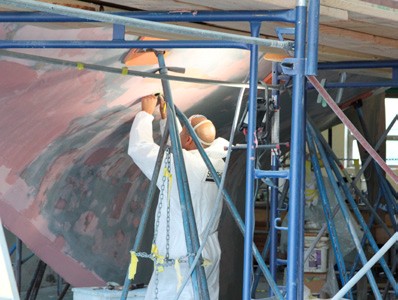Part 1
By Andrew Cooley
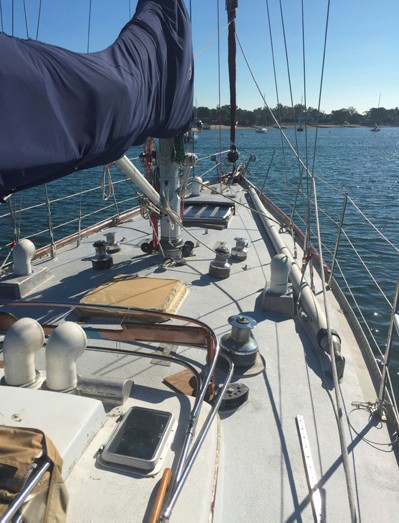 Welcome to the first in a series of articles detailing one of our most current projects at Cooley Marine Management, the refit of s/y Scaramouche. We will follow along in real time as our team works to restore this iconic vessel.
Welcome to the first in a series of articles detailing one of our most current projects at Cooley Marine Management, the refit of s/y Scaramouche. We will follow along in real time as our team works to restore this iconic vessel.
There’s plenty of work to do on deck, but Phase 1 of Scaramouche’s refit began below the rubrail. © cooleymarine.com
Designed by Sparkman & Stephens and built in 1972 by the Palmer Johnson Shipyard in Sturgeon Bay, WI, the 50-foot Scaramouche is a classic example of the aluminum ocean racers of that era. One of three near sister ships built by PJ from 1968 to ’72, her design reflects the trends of the time: short keel, trim tab, separate rudder, and weight concentrated low and amidships. The interior is well suited for long distance racing.
Scaramouche has led a storied life in the annals of yacht racing, but as with all great boats her time as the leader has passed and she was left out to pasture. Her current (new) owner felt that yearning that many sailors have, but few act upon. He discovered her on the hard in British Columbia, Canada, and knowing her pedigree, purchased her outright and had her trucked across North America to her new home here in Connecticut in the spring of 2016.
The owner’s first goal in the restoration project was fitting Scaramouche with a new GMT carbon mast and boom package. With the new rig in place, she spent the summer of 2016 getting her feet wet on the waters of Long Island Sound as her owner learned the nuances of this classic yacht. To his pleasant surprise, the boat truly cuts through the water with ease and minimal wake for such a large vessel…a credit to her designers.
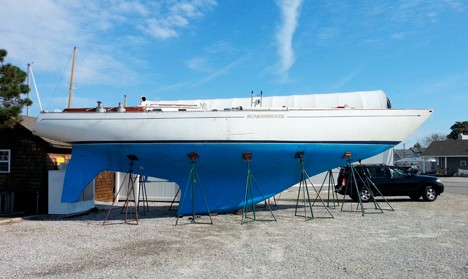
Not bad for 45 years old, although media blasting would reveal the scope of the job ahead. © cooleymarine.com
With the satisfaction of knowing that the boat sails as hoped, the owner decided to turn his attention to the next stage of the project, the hull refit. That’s where Cooley Marine Management (CMM) was first introduced to the project. After several meetings and inspections of the boat, the plan was set for the refit. Phase I, which commenced earlier this year, includes a full media blast of the underwater hull and a sweep of the trouble spots on the topsides. The objective for Phase I is a comprehensive renewal of the surfaces from the keel to the rubrail. The end result will be a fresh new bottom and fresh Awlgrip on the hull topsides. This job included an extensive amount of reworking and fairing, as many of the hull areas needed to be taken down to bare aluminum and reworked from scratch.
In addition to the coatings refit, the owner is reconfiguring the lower standing rigging and adding new chainplates, as well as modifying the bow to incorporate a new removable carbon sprit for racing and an anchor roller assembly for cruising.
Phase II, set for next winter, will focus on the restoration of the decks, with new nonskid and continued overhaul of the sailing hardware. The overall outcome will result in the complete restoration of an iconic sailing yacht and set the stage for her resurgence on our local waters and beyond.
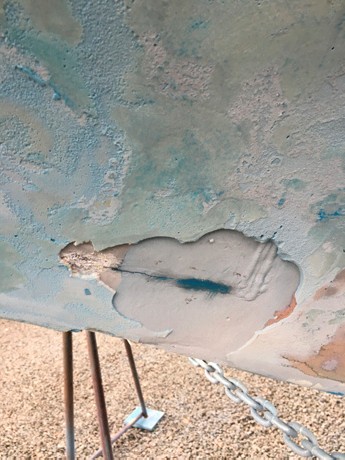 At the time of writing this article, Scaramouche has undergone the media blasting of the underwater hull and spot areas initially noted on the hull sides. While there were several areas of the underwater hull where the fairing compounds had failed, surprisingly, well over 80% of the original fairing and primers were still intact and able to be reworked. The same held true for the topsides. While we could see certain areas had failed before ever hauling the boat, nothing grew dramatically worse during the blasting and initial sanding.
At the time of writing this article, Scaramouche has undergone the media blasting of the underwater hull and spot areas initially noted on the hull sides. While there were several areas of the underwater hull where the fairing compounds had failed, surprisingly, well over 80% of the original fairing and primers were still intact and able to be reworked. The same held true for the topsides. While we could see certain areas had failed before ever hauling the boat, nothing grew dramatically worse during the blasting and initial sanding.
As expected, several areas below the waterline needed lots of reworking. © cooleymarine.com
As we continue to follow up with the project over the next few issues, we will dive into greater detail on the various repair procedures used to correct the effects of aging on an aluminum vessel. We will also follow along with what discoveries are made during the process which will help further inform readers and other owners of the expectations each should have when embarking on a refit project. ■
Part II
Since our last update, the mighty Scaramouche has undergone quite the transformation and is now full swing in the structural and asthetic refit.
Having previously completed all of the media blasting, Cooley Marine Management team got straight to work on fully exposing the problem areas of both the underwater hull and the topsides. Our team started the process of quantifying the full scope of the needed repairs. We do this by laying a grid pattern directly on the hull surfaces, which gives the guys on the floor a visual representation of the areas where the heaviest work is needed as well as serving as a photo record for the client to track the scope of work. Ultimately, we found that over 20% of the underwater hull needed to be stripped back to bare aluminum and started from scratch. In the process, the owner also decided that there were a number of unused thru-hull fittings from years of modifications.
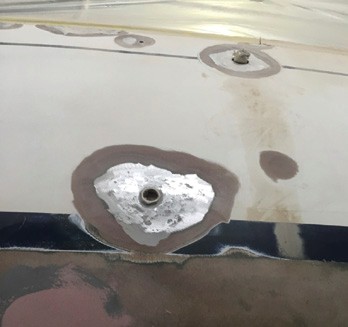 This was the best time to completely remove those fittings and permanently seal the hull at those locations. The various intakes and overboards were carefully cut free from the hull and new aluminum plates were inserted in place and bonded to the hull. Those locations were then primed, filled and faired to match the surrounding hull surfaces. The end result of all of these closures is a much more sound and secure hull with years of unused piping and outdated fittings cleared out.
This was the best time to completely remove those fittings and permanently seal the hull at those locations. The various intakes and overboards were carefully cut free from the hull and new aluminum plates were inserted in place and bonded to the hull. Those locations were then primed, filled and faired to match the surrounding hull surfaces. The end result of all of these closures is a much more sound and secure hull with years of unused piping and outdated fittings cleared out.
During the course of the refit, we worked with the owner to identify which fittings were no longer needed, removed the hardware and sealed the hull back up. Once the structural repair was made the surfaces needed to be built back up with a series of steps which include: a metal primer, fairing compound, high build primer, and finishing primers before the final topcoat is applied to the entire hull.
One of the other major objectives during this first phase of the refit process has been working with the owner and his team to incorporate several structural modifications to facilitate some modern sailing features not known at the time of Scaramouche’s creation in 1972. The first of these is the addition of a custom bowsprit bracket which will do double duty as the support for the new carbon spinnaker sprit for racing and an anchor roller support pad for when the owner wishes to cruise and explore the anchorages of Long Island Sound and afar. The owner and his team, having come up with an efficient design, worked directly with our team on the shop floor to fabricate, fit and weld the new aluminum housing to the bow of the boat. The design included the removal of a section of the forward starboard bow gunnel, relocation of the starboard hawse pipe, fit-up and welding of the unit to the hull, and ultimately fairing and finishing of the new structure to ensure that once complete, the new unit will look as if it was always a part of the vessel.
In addition to the bow modifications, the other major structural change during this refit was the addition of new chainplates for the lower shrouds. As was typical of ocean racers of her day, Scaramouche was originally fitted with both forward and aft lowers to support the large aluminum masts of the 1970s. Since replacing that rig with a modern carbon fiber mast last year, the owner and his team found that the double lower sets are no longer needed, and removing them will save weight and clear out much needed deck space for increased sail sizes and racing configurations. The new rigging package replaces both lowers with a single lower, but it needed a deck termination not originally designed by Sparkman & Stephens. Once again, the owner and his team came up with an effective and efficient design that was perfectly suited to accomplish during this refit period. The chainplates themselves were prefabricated and shaped to match the curve coming through the deck to meet the angle of the new lower shrouds. To support the new chainplates internally, aluminum plate was shaped to match the hull curvature and welded in across several stringer frames to give both strength and spread stress loads across the hull.
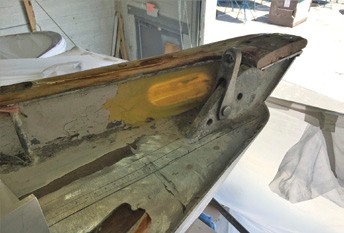
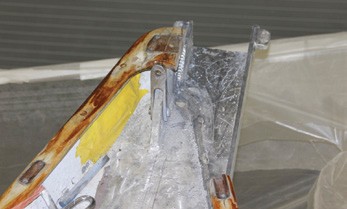
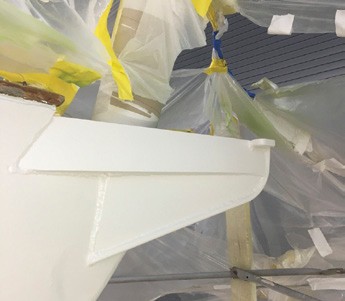
One of the owner’s major objectives with the refit was to modify the bow to allow for the deployment of a new carbon sprit pole for racing. In doing so, they did not want to sacrifice the ability to use the anchor while cruising. The designed solution required cutting through the existing bulwarks and extending an aluminum channel forward of the bow. Both the new sprit and the anchor roller can be secured into the channel as needed, and when not in use stowed away. The modifications required an extensive amount of fairing and paint work to make the piece look as if it was always part of the design.
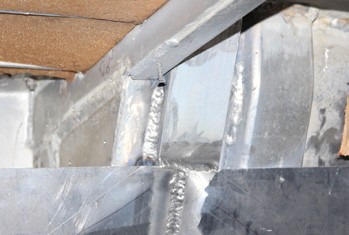
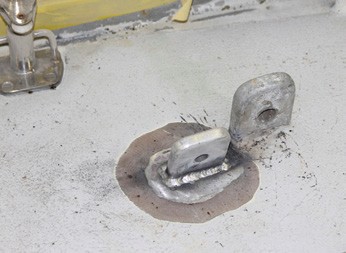
Another structural addition of the refit was to fabricate and install new chainplates for the new lower standing rigging. The below deck attachments were welded to the hull stringers. The alignment of the new plates required tying together a series of stringers to provide ample strength to support the anticipated loads of the new rigging.
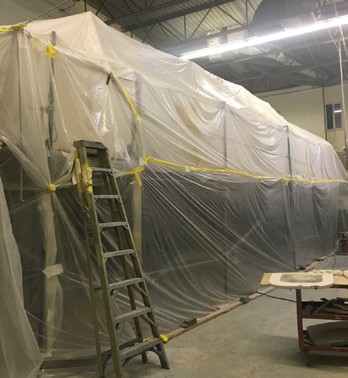 With the major repairs and modifications complete, we turned our full attention to the arduous task of prepping the vessel for paint. As with any good paint job, the devil is in the prep. This boat proved to be no different. With years of bumps with docks and launches, rafts ups, water ingress, corrosion caused by dissimilar metals, thousands of miles under her keel and who knows what else, the topsides were really showing her age.
With the major repairs and modifications complete, we turned our full attention to the arduous task of prepping the vessel for paint. As with any good paint job, the devil is in the prep. This boat proved to be no different. With years of bumps with docks and launches, rafts ups, water ingress, corrosion caused by dissimilar metals, thousands of miles under her keel and who knows what else, the topsides were really showing her age.
After over 500 man hours of work, countless gallons of fairing compounds, primers, solvents and miles of tape and plastic, Scaramouche is in final finish primer (AwlGrip 545). The CMM team is in final prep for the high gloss topcoat and application of the new bottom paints.
In addition to the new metal work at the bow, we started chasing a number of small chips and dings which ultimately required an larger percentage of the topside hull needing to be worked back down to bare aluminum, primed, and extensively faired with epoxy fairing compounds to ensure that when it’s time to apply that final high gloss topcoat, all that one sees is the stellar lines of her classic design and storied pedigree.
Stay tuned for next month’s edition, where we hope to be showing off the finish results of Phase I… ■
Part III
Welcome to the final installment of Phase I refit of the mighty Scaramouche. Since the last issue our team has fully completed all of the final finish coats to the hull topsides, striping details, and bottom painting. Scaramouche is now in the water and back at her homeport of Stamford, CT and her owner is eager to get some more miles under her keel.
As with any large project, the push to the end is often the most challenging time. This project was no different. The owner had selected AwlGrip for the final topcoats, and in order to deliver the desired high gloss luster, our team meticulously examined the primed surfaces to ensure a smooth and consistent substrate to apply the final coats.
Fitout and install of the new transducer. Careful attention must be paid to proper alignment to ensure accurate functioning of the new unit. Once installed, the area was faired to the surrounding hull so that the vessel glides smoothly and effortlessly through the water. © cooleymarine.com
With the confidence that all the prep had been completed, the team turned their attention to ensuring the paint booth was ready. Before final coats are applied, the booth must be thoroughly cleaned, all scaffolding washed and wrapped, plastics torn down and new plastic sheeting installed, all tapes changed and unpainted areas protected. Once fully prepped, the final coats are applied in a series of consecutive paint shoots that take most of the day to apply. The paint is left to cure for several days before recovering and marking out of the striping details. In marking out the new cove stripe, the decision was made to resurrect the classic arrow of Sparkman & Stephens yachts. After a few timely phone calls and email exchanges, S&S provided a scalable drawing for our paint team to re-create the iconic detail just in the nick of time.
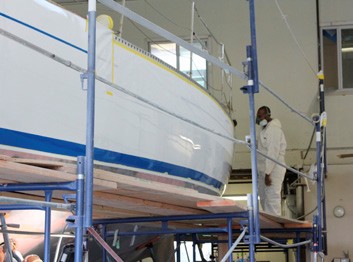 With the final topside coatings completed, the integrated aluminum toe rail needed touching up. The freshly painted hull was covered and protect, and the bare aluminum was coated with a protective clear coat. © cooleymarine.com
With the final topside coatings completed, the integrated aluminum toe rail needed touching up. The freshly painted hull was covered and protect, and the bare aluminum was coated with a protective clear coat. © cooleymarine.com
Once the final topside coatings had been applied, the team turned their attention to finishing off the underwater hull. Having spent an extensive amount of time re-fairing the bottom, the final bottom coats are as critical as the topsides. Scaramouche’s new owner was steadfast in his decision to mitigate the chances of corrosion. The bottom paint system is comprised of a robust commercial grade epoxy barrier coats finished with completely copper-free bottom paint.
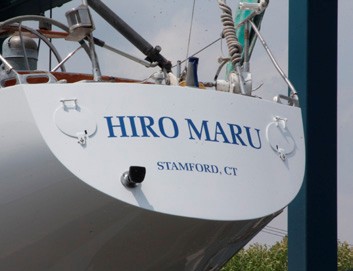 With the bottom and topsides in pristine condition, Scaramouche’s new owner decided to rename the boat in keeping with his and his family’s history. However, in homage to the boat’s storied history, he and his wife designed a stunning yet subtle graphic which carries on the famed boat name, Scaramouche. The final stages of the refit included installation of removed hardware and fittings, replacement of the underwater hull/running gear anodes, and paint touch-ups to the foredeck. Once completed, the team at Brewer Stratford Marina skillfully transferred the boat from our facility onto the Travelift and safely launched her with no incident. Given the boat’s deep draft, both the launch and stepping the mast had to be scheduled on the high tide, but all went smoothly even with this summer’s unpredictable weather.
With the bottom and topsides in pristine condition, Scaramouche’s new owner decided to rename the boat in keeping with his and his family’s history. However, in homage to the boat’s storied history, he and his wife designed a stunning yet subtle graphic which carries on the famed boat name, Scaramouche. The final stages of the refit included installation of removed hardware and fittings, replacement of the underwater hull/running gear anodes, and paint touch-ups to the foredeck. Once completed, the team at Brewer Stratford Marina skillfully transferred the boat from our facility onto the Travelift and safely launched her with no incident. Given the boat’s deep draft, both the launch and stepping the mast had to be scheduled on the high tide, but all went smoothly even with this summer’s unpredictable weather.
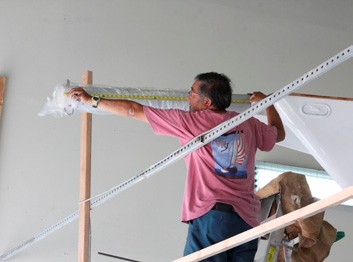 As a hands-on owner, Hiro Nakajima has been involved with every step of this project.
As a hands-on owner, Hiro Nakajima has been involved with every step of this project.
After commissioning the systems and engines, Scaramouche’s owner and crew sailed her proudly down the Housatonic and back to Stamford Harbor. She will spend the remainder of the summer and early fall on the water, enjoying her new touches and prepping for next year’s Newport Bermuda Race. She will be back in our shop this winter, where the team will carry out Phase II by renewing the decks and house. Keep an eye out for this classic beauty this summer on the Sound! ■
Andrew Cooley is the owner of Cooley Marine Management, LLC in Stratford, CT. With a background in marine repair and project management, he is well versed in both new construction and refits. To learn more about CMM’s repair, refit, project management, consulting and marine general contracting services, visit cooleymarine.com.


